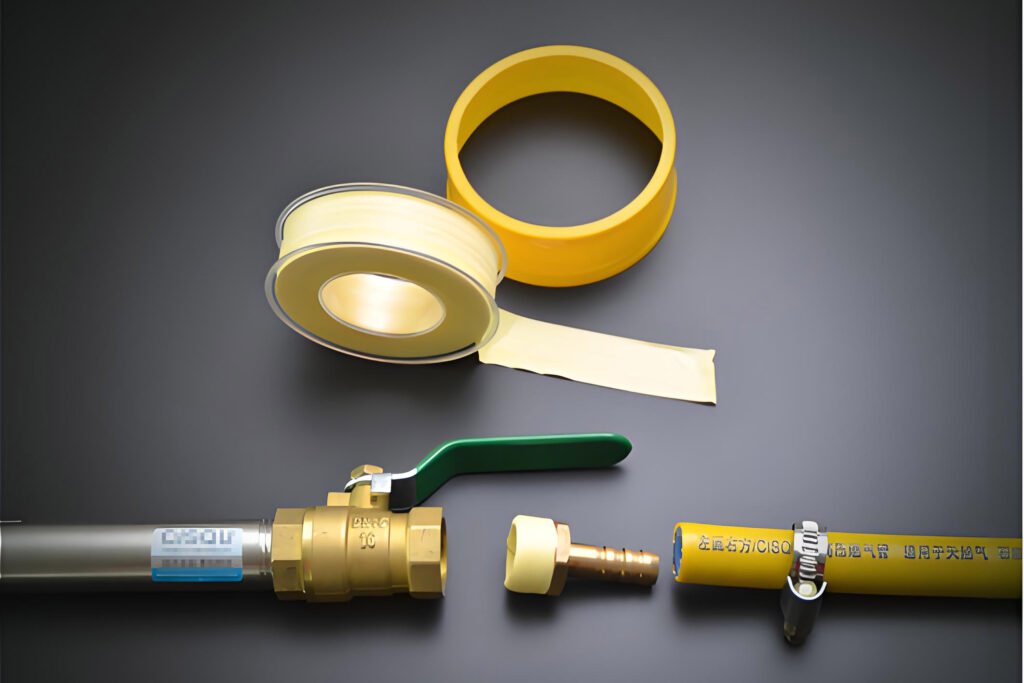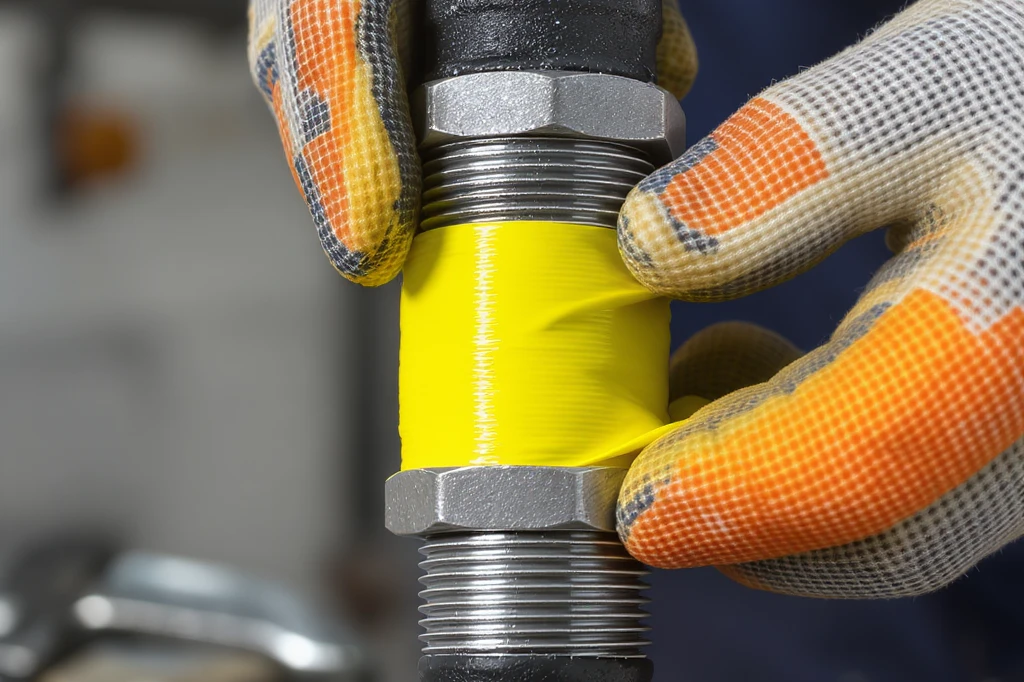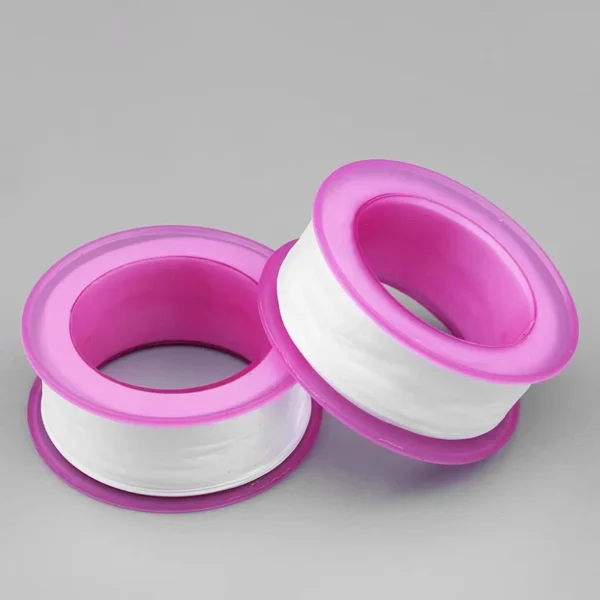배관 공사를 할 때면 거의 본능적으로 나사산 밀봉 테이프(흔히 테플론 테이프라고 불립니다)를 찾게 됩니다. 간단하고 저렴하면서도 누수 없는 연결부를 보장하는 데 필수적인 도구입니다. 전문가의 공구함에서는 여러 종류의 테이프 롤을 볼 수 있을 겁니다. 일반적인 흰색, 분홍색, 그리고 독특한 노란색 테이프가 있죠.
훈련받지 않은 사람의 눈에는 그 둘은 서로 바꿔 쓸 수 있는 것처럼 보일 수도 있습니다. 그냥 테이프일 뿐이잖아요?
틀렸습니다. 가스 배관에 있어서 이러한 가정은 틀릴 뿐만 아니라 위험하기까지 합니다. PTFE 테이프의 색상은 미관상의 선택이 아닙니다. 중요한 안전 규정입니다. 천연가스나 프로판 가스 배관에 잘못된 테이프를 사용하면 감지하기 어려운 누출이 서서히 발생하여 화재나 폭발의 심각한 위험을 초래할 수 있습니다.
~에 테프론 X저희는 최고 품질의 실링 솔루션을 제조하고 공급하는 데 전념해 왔습니다. 사소한 실수가 가져오는 결과와 올바른 자재 사용으로 얻는 마음의 평화를 직접 경험했습니다.
PTFE 테이프는 정확히 무엇인가요?
색상에 대해 자세히 알아보기 전에, 먼저 기준을 정해 보겠습니다. PTFE는 폴리테트라플루오로에틸렌(Polytetrafluoroethylene)의 약자로, 테트라플루오로에틸렌의 합성 불소 중합체입니다. 1938년 듀폰에서 우연히 발견되었으며, 테플론(Teflon)이라는 브랜드명으로 가장 잘 알려져 있습니다.
이 제품의 특성은 파이프 나사산에 탁월한 밀봉제로 작용합니다.
- 매우 낮은 마찰: 윤활제 역할을 하여 나사산을 더 쉽고 완벽하게 조여 밀봉을 강화합니다.
- 화학적으로 불활성: 물과 많은 용매를 포함한 대부분의 일반적인 화학 물질과 반응하지 않습니다.
- 온순한: 압력이 가해지면 나사산 틈으로 변형되어 잠재적인 누출 경로를 효과적으로 채웁니다.
PTFE 테이프는 본질적으로 화학적 밀봉을 생성하지 않습니다. 나사산 연결부를 통해 유체와 기체가 빠져나가는 것을 방지하는 물리적 장벽을 형성합니다. 하지만 모든 물리적 장벽이 동일하게 만들어지는 것은 아닙니다.
유니버설 컬러 코드: 아름다운 색상 그 이상
배관 및 가스 설비 산업은 안전과 상호 운용성을 보장하기 위해 표준에 의존합니다. PTFE 테이프의 색상은 이러한 불문율, 때로는 공식적으로 명시된 법규 중 하나입니다. 각 색상은 서로 다른 밀도, 두께, 그리고 용도를 나타냅니다.
- 하얀색: 일반 용도의 급수관에 사용되는 표준 밀도입니다.
- 분홍색: 물과 증기 라인에 더 높은 밀도를 사용합니다(배관공이 자주 사용).
- 녹색: 오일 프리, 산소 라인용.
- 회색/은색: 고밀도에 고착 방지 화합물을 첨가하여 스테인리스 스틸과 알루미늄에 적합합니다.
- 노란색: 특히 가스관에 가장 높은 밀도를 제공합니다.
이 규정을 이해하는 것은 전문적이고 안전한 파이프 피팅을 위한 첫 번째 단계입니다.
흰 테이프: 물에 대한 일반주의자, 가스에 대한 위험
표준 흰색 PTFE 테이프는 철물점에서 가장 흔히 볼 수 있는 테이프입니다. 샤워헤드나 싱크대 아래 수도 연결부 나사산을 밀봉하는 등 기본적인 배관 작업에 적합합니다.
- 밀도: 단일 밀도 또는 표준 밀도 테이프입니다. 비교적 얇고 비교적 큰 물 분자를 차단하도록 설계되었습니다.
- 압력 등급: 일반적으로 100 PSI 이하의 일반 가정용 수압에 적합합니다.

그렇다면 흰색 테프론 테이프를 가스에 사용할 수 있을까요?
답은 명확하고 절대적입니다. 아니요.
가스관에 표준 흰색 PTFE 테이프를 사용하는 것은 대부분의 관할 지역에서 심각한 안전 위반이자 위험한 도박입니다. 그 이유는 다음과 같습니다.
- 밀도가 부족함: 천연가스와 프로판 분자는 물 분자보다 훨씬 작습니다. 표준 밀도 흰색 테이프의 미세한 기공과 직조는 이러한 작은 가스 분자를 안정적으로 가두기에 충분히 촘촘하지 않습니다. 시간이 지남에 따라 가스가 테이프를 직접 스며들어 느리고 만성적인 누출을 유발할 수 있습니다.
- 저하 가능성: PTFE는 일반적으로 불활성이지만, 기본 백색 테이프의 첨가제 및 제조 공정은 가스에 함유된 특정 탄화수소 및 냄새 물질(예: 메르캅탄)에 대한 테스트를 거치지 않았습니다. 이러한 화합물은 테이프를 손상시켜 밀봉 성능을 저하시킬 수 있습니다.
- 인증 부족: 흰색 테이프는 UL(Underwriters Laboratories)이나 IFGC(International Fuel Gas Code) 등 가스 부속품에 요구되는 엄격한 기준을 충족하도록 제조되거나 테스트되지 않았습니다. 흰색 테이프로 밀봉된 부속품은 전문가 검사에서 즉시 불합격 처리됩니다.
마치 낚싯줄에 모래를 담아두는 것과 같다고 생각해 보세요. 모래알 몇 개는 남아 있을지 몰라도 대부분은 빠져나갈 겁니다. 가스관에 흰색 테이프를 붙이면 바로 이런 일이 벌어지죠.
노란색 테이프: 가스 안전을 위한 엔지니어링 솔루션
이제 우리 이야기의 주인공인 노란색에 대해 이야기해 보겠습니다. 가스 정격 PTFE 테이프이 테이프는 단순히 식별을 위해 노란색으로 칠해진 것이 아닙니다. 재료 구성과 구조가 근본적으로 다릅니다.
우리 자신의 가스 라인용 노란색 PTFE 테이프 | 고밀도 나사산 밀봉 테이프 특정한 중요한 작업을 위해 설계된 제품의 완벽한 예입니다.
다른 점들은 다음과 같습니다.
- 고밀도: 노란색 가스 테이프는 훨씬 더 높은 밀도 기준으로 제조됩니다. 흰색 테이프보다 눈에 띄게 두껍고 무겁습니다. 이렇게 밀도가 높은 구조는 훨씬 더 견고하고 불침투성인 장벽을 형성하여 아주 작은 가스 분자까지도 효과적으로 가두어 둡니다.
- 더 두꺼운 두께: 두께가 두꺼워지면서 테이프가 더 깊은 실과 더 큰 결함을 더 효과적으로 채울 수 있게 되어 압력 하에서도 견고하고 누출 방지 밀봉이 보장됩니다.
- 화학적 호환성: 천연가스, 프로판, 부탄 및 기타 연료 가스는 물론, 이에 함유된 오일 및 화학 물질에도 불활성으로 특별히 제조 및 테스트되었습니다. 시간이 지나도 분해되거나 깨지지 않습니다.
- 기준을 충족하거나 초과함: 신뢰할 수 있는 노란색 PTFE 테이프는 안전 기관 및 가스 규정의 요건을 충족하거나 초과하도록 설계되었습니다. 예를 들어, 미국에서는 많은 가스 테이프가 UL 인증을 받았으며, 유럽에서는 EN 751-3과 같은 표준을 준수할 수 있습니다. 이 인증은 제품이 의도된 용도에 맞게 엄격한 테스트를 거쳤음을 보장합니다.
제품 설명에 명시된 바와 같이 "더 두껍고 견고한 천연가스, 프로판 및 부탄 피팅용 씰로 최대의 안전을 보장합니다." 이것이 바로 핵심 목적입니다. 천연가스용 PTFE 테이프.
직접 비교: 노란색 대 흰색 테프론 테이프
차이점을 확실히 알아보기 위해 표로 나란히 정리해보겠습니다.
| 특징 | 흰색 PTFE 테이프(표준) | 노란색 PTFE 테이프(가스 등급) | 가스 라인에 중요한 이유 |
|---|---|---|---|
| 1차 응용 프로그램 | 일반 용도, 물 라인(NPT 나사산 최대 1.5인치) | 가스관(천연가스, 프로판, 부탄), 연료유관 | 의도된 용도가 아닌 다른 용도로 제품을 사용하면 고장의 원인이 됩니다. 가스관에는 수도관과 달리 고유한 안전 요건이 적용됩니다. |
| 재료 밀도 | 표준 밀도(예: < 0.70 g/cm³) | 고밀도(예: > 1.2 g/cm³) | 이것이 가장 중요한 차이점입니다. 고밀도에서는 작은 기체 분자에 대해 불침투성 밀봉을 형성합니다. 표준 밀도에서는 그렇지 않습니다. |
| 두께 | 더 얇은(예: ~2.5밀) | 더 두껍습니다(예: ~4밀 이상) | 더 두꺼운 테이프는 나사산의 불완전한 부분을 더 완벽하게 채우고, 특히 대구경 파이프의 경우 내구성 있고 오래 지속되는 밀봉을 위한 더 많은 재료를 제공합니다. |
| 색상 | 하얀색 | 노란색 | 노란색은 검사관, 기술자, 심지어 주택 소유자에게도 보편적인 안전 표시로, 가스관이 올바른 재질로 밀봉되어 있다는 것을 즉시 나타냅니다. |
| 관련 표준 | 일반적으로 가스에 특화된 것은 없습니다. | UL, MIL-SPEC T-27730A, EN 751-3과 같은 표준을 충족하거나 초과합니다. | 인증은 테이프가 지정된 용도에 안전하고 효과적임을 제3자가 검증하는 제도입니다. 이는 품질과 성능을 보증하는 것입니다. |
| 가스관 안전 | 안전하지 않음 - 사용하지 마십시오 | 안전 - 유일하게 올바른 선택 | 귀하의 재산과 그 안에 있는 사람들의 안전은 정확하고 인증된 자재 사용에 달려 있습니다. 이 점에 있어서는 타협이란 없습니다. |
실제 세계의 결과: 현장에서 얻은 교훈
~에 테프론 X, 우리는 종종 계약업체 및 유지보수팀과 협의합니다. 그중 한 익명의 사례가 눈에 띕니다. 한 부동산 관리 회사가 새로 리모델링한 아파트 단지에서 지속적인 문제를 겪고 있었습니다. 여러 세대가 최종 가스 압력 검사에서 불합격하여 입주가 지연되었고, 회사는 임대료 손실과 재검사 수수료로 수천 달러의 손실을 입었습니다.
유지보수 직원들은 난감해했습니다. 부속품은 새것이고 배관도 문제없었습니다. 꼼꼼한 감사를 통해 공급망의 불안정성에서 문제의 원인을 찾아낼 수 있었습니다. 배관 하청업체 중 일부는 부속품 하나당 몇 센트라도 아끼려고 스토브와 건조기 가스관에 대량 구매한 흰색 PTFE 테이프를 사용하고 있었습니다.
그들이 우리의 독점적 사용을 명령한 순간 고밀도 노란색 PTFE 테이프 프로젝트 전체에 걸쳐 문제는 사라졌습니다. 이후 모든 장치는 첫 번째 시도에서 압력 테스트를 통과했습니다. 적절한 테이프에 대한 초기 투자가 적었기 때문에 잠재적인 재앙과 상당한 재정적 손실을 피할 수 있었습니다. 이 시나리오는 다음과 같은 점을 완벽하게 보여줍니다. 노란색 대 흰색 테프론 테이프 이 질문에 대한 정답은 실질적인 안전과 재정적 이점이 있습니다.
가스 정격 PTFE 테이프를 올바르게 적용하는 방법
올바른 테이프를 사용하는 것이 첫 번째 단계입니다. 두 번째 단계는 올바르게 붙이는 것입니다. 매번 완벽한 밀봉을 보장하는 간단한 가이드를 소개합니다.
- 스레드를 청소하세요: 수나사와 암나사 모두 깨끗해야 하며 먼지, 기름때, 또는 오래된 테이프가 없어야 합니다. 필요한 경우 와이어 브러시를 사용하십시오.
- 올바른 방향으로 포장: 파이프의 열린 쪽이 자신을 향하도록 하세요. 테이프를 수나사 주위에 시계 방향으로 감으세요. 이렇게 하면 피팅을 조일 때 마찰로 인해 테이프가 풀리는 것을 방지할 수 있습니다.
- 긴장감을 가지고 적용하세요: 테이프를 감을 때 약간의 팽팽함을 유지하여 실에 꼭 맞게 감을 수 있도록 합니다.
- 오버랩 및 커버: 테이프를 한 번 감쌀 때마다 너비의 절반 정도씩 겹쳐 감으세요. 대부분의 가스 피팅은 3~5회 감으면 충분합니다. 너무 많은 테이프를 사용하면 피팅이 제대로 조여지지 않으므로, 모든 나사산을 완전히 덮는 것이 중요합니다.
- 부드럽게 하세요: 테이프를 감은 후 손가락을 테이프 위로 움직여 실에 단단히 눌러 넣습니다.
- 단단히 조이세요: 조인트를 조립하고 적절한 렌치로 조이세요. 조인 후에는 피팅을 뒤로 빼지 마세요. 씰이 파손될 수 있습니다.
당신의 안전은 타협할 수 없습니다. 당신에게 맞는 파트너를 선택하세요.
노란색과 흰색 PTFE 테이프 중 어떤 것을 선택할지는 단순히 취향 문제가 아니라 안전, 규정 준수, 그리고 전문성의 문제입니다. 잘못된 제품을 사용할 경우 발생할 수 있는 결과는 너무나 심각하여 무시할 수 없습니다.
~에 테프론 X저희는 단순히 제품을 판매하는 데 그치지 않습니다. 저희는 귀사의 프로젝트에서 신뢰할 수 있는 파트너가 되어, 귀사가 작업을 제대로 수행할 수 있도록 필요한 지식과 고품질 자재를 제공하겠습니다. 가스 정격 PTFE 테이프 우리는 무엇이 위험에 처해 있는지 알고 있기 때문에 가장 높은 사양에 따라 제조됩니다.
집, 프로젝트, 고객의 안전을 우연에 맡기지 마세요. 가스관을 발견하면 올바른 선택은 오직 하나뿐입니다.
귀하의 프로젝트가 최고의 안전 기준을 충족하는지 확인할 준비가 되셨나요?
- 업계 최고의 제품을 살펴보세요 가스 라인용 노란색 PTFE 테이프 저희 웹사이트에서.
- 대규모 프로젝트나 특정 기술 관련 질문이 있으신가요? Teflon X 전문가 팀에 문의하세요 개인 맞춤형 견적이나 자세한 상담을 원하시면 문의하세요.
- 직접 문의사항이 있으시면 밀봉 전문가인 Allison Ye에게 Allison.Ye@teflonx.com으로 연락하세요.
안전하고 전문적인 선택을 하세요. 노란색을 선택하세요. 테프론 X.
자주 묻는 질문(FAQ)
Q1: 가스관에 흰색 테프론 테이프를 이미 사용했습니다. 어떻게 해야 하나요?
에이: 이 문제는 잠재적 안전 위험으로 간주해야 합니다. 연결 부위를 즉시 차단하고 분해하여 세척한 후 올바른 노란색 고밀도 접착제를 사용하여 다시 밀봉해야 합니다. 가스 정격 PTFE 테이프직접 하는 데 자신이 없으시다면 해당 기기의 가스 공급을 차단하고 즉시 면허를 소지한 배관공이나 가스 설비 기술자에게 연락하세요. 안심하실 수 있으니 서비스 센터에 전화하실 가치가 있습니다.
Q2: 노란색 PTFE 테이프가 흰색 테이프보다 비싼가요?
에이: 네, 노란색 PTFE 테이프는 밀도가 높고 두께가 두껍고 엄격한 테스트를 거치기 때문에 일반 흰색 테이프보다 일반적으로 약간 더 비쌉니다. 하지만 가격 차이는 미미하여 롤당 몇 달러 정도밖에 나지 않습니다. 이러한 작은 추가 비용으로 가스 누출, 화재, 폭발과 같은 치명적인 위험을 예방할 수 있다는 점을 고려하면 안전에 대한 필수적이고 가치 있는 투자입니다.
Q3: 노란색 PTFE 테이프를 수도관에 사용할 수 있나요?
에이: 네, 가능합니다. 노란색 테이프는 품질과 밀도가 더 높기 때문에 수도관 밀봉에 아주 적합합니다. 하지만 이 작업에는 기본적으로 과도하게 적합합니다. 하지만 비용 효율적이지 않습니다. 표준형의 저렴한 흰색(또는 분홍색) 테이프는 수도 관련 작업에 아주 적합합니다. 중요한 점은 품질을 변경할 수 있다는 것입니다(수도용 대신 노란색 테이프 사용). 절대 (가스를 대신하는 흰색)을 대체합니다.
가스 라인용 노란색 PTFE 테이프 | 고밀도 나사산 밀봉 테이프
가스 배관용으로 특별히 설계된 노란색 PTFE 테이프로 최고의 안전을 보장하세요. 고밀도 노란색 실링 테이프는 천연가스, 프로판, 부탄 배관에 더욱 두껍고 견고한 밀봉을 제공합니다. 업계 표준을 뛰어넘는 가스 배관용 PTFE 테이프는 위험한 누출을 효과적으로 방지합니다.



